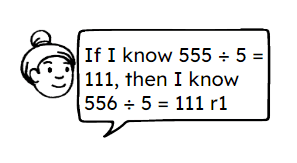Myths about teaching can hold you back
- Year 5
Divide using partitioning and representations (multiple regroups and remainder)
I can divide using partitioning and representations (multiple regroups and remainder)
- Year 5
Divide using partitioning and representations (multiple regroups and remainder)
I can divide using partitioning and representations (multiple regroups and remainder)
These resources will be removed by end of Summer Term 2025.
Switch to our new teaching resources now - designed by teachers and leading subject experts, and tested in classrooms.
These resources were created for remote use during the pandemic and are not designed for classroom teaching.
Lesson details
Key learning points
- If the hundreds number is not a multiple of the divisor then the remainder is regrouped for tens.
- If the tens number is not a multiple of the divisor then the remainder is regrouped for ones.
- If the ones number is not a multiple of the divisor then there will be a remainder in the answer.
- Regrouping and remainders can be represented practically using place value counters.
Keywords
Remainder - A remainder is an amount left over after division.
Partitioning - Partition means splitting a number into parts.
Regroup / regrouping - The process of unitising and exchanging between place values is known as regrouping.
Common misconception
Pupils may not regroup correctly.
Ask pupils what each digit represents. Continue to use skip counting when dividing each digit in the dividend.
To help you plan your year 5 maths lesson on: Divide using partitioning and representations (multiple regroups and remainder), download all teaching resources for free and adapt to suit your pupils' needs...
To help you plan your year 5 maths lesson on: Divide using partitioning and representations (multiple regroups and remainder), download all teaching resources for free and adapt to suit your pupils' needs.
The starter quiz will activate and check your pupils' prior knowledge, with versions available both with and without answers in PDF format.
We use learning cycles to break down learning into key concepts or ideas linked to the learning outcome. Each learning cycle features explanations with checks for understanding and practice tasks with feedback. All of this is found in our slide decks, ready for you to download and edit. The practice tasks are also available as printable worksheets and some lessons have additional materials with extra material you might need for teaching the lesson.
The assessment exit quiz will test your pupils' understanding of the key learning points.
Our video is a tool for planning, showing how other teachers might teach the lesson, offering helpful tips, modelled explanations and inspiration for your own delivery in the classroom. Plus, you can set it as homework or revision for pupils and keep their learning on track by sharing an online pupil version of this lesson.
Explore more key stage 2 maths lessons from the Division by partitioning leading to short division (2 and 3-digits by 1-digit) unit, dive into the full primary maths curriculum, or learn more about lesson planning.

Licence
Prior knowledge starter quiz
6 Questions
Q1.Which of these numbers are not multiples of five?
Q2.The __________ is 5, this is the number we are dividing by.

Q3.If you divided these dividends by 8, which would require regrouping?
Q4.Your divisor is 5. Select the division equations which will result in a remainder. Use the part whole model to help you.

Q5.Use partitioning to solve: 65 ÷ 4. Write your answer in numeral form using r if there is a remainder.
Q6.Andeep has collected 71 football cards. He wants to divide them equally amongst 3 of his friends. How many cards does each child get? Are there any left over? Write your answer in numeral form.
Assessment exit quiz
6 Questions
Q1.Match the division equation to the correct quotient:
8
8
1
0
1 ten
8 tens
Q2.In 524 ÷ 4 = 131 the __________ is 4
Q3.If you were to divide each number by 3, which would require regrouping?
Q4.Look at Andeep's mental strategy. Using his information fill in the gap: 557 ÷ 5 = ___



